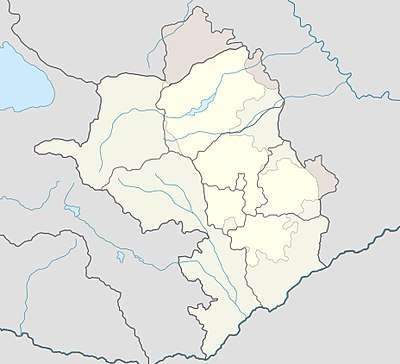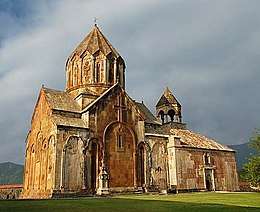Vank, Karabakh
Vank (Armenian: Վանք, lit. "monastery"; Azerbaijani: Vəngli) is an Armenian-populated village located in the disputed region of Nagorno-Karabakh (de jure part of Azerbaijan, but de facto administrated by the Republic of Artsakh). Its population in 2005 stood at 1,284.[1]
Vank | |
|---|---|
The village of Vank as seen from Gandzasar Monastery. | |
 Vank | |
| Coordinates: 40°03′28″N 46°32′44″E | |
| de facto Country | |
| de facto Province | Martakert |
| de jure Country | |
| de jure Rayon | Kalbajar |
| Elevation | 1,031 m (3,383 ft) |
| Population (2005) | |
| • Total | 1,284 |
| Time zone | UTC+4 (ART) |
| • Summer (DST) | UTC+5 (ArT) |
The village of Vank is surrounded by several historical monuments dating to the Middle Ages. The most prominent among them is the thirteenth-century monastic complex of Gandzasar (built from 1216-38), which overlooks the village and was built by the Armenian ruler of the principality of Khachen, Prince Hasan-Jalal Dawla.[2][3]
In the years following the conclusion of the Nagorno-Karabakh War (1988-1994), the village has seen an increase in investment from the Armenian diaspora. Levon Hairapetyan, a Russian-based Armenian businessman and a native of Vank, has funded the reconstruction of homes, the local school, and sponsored the building of a zoo [4] and the nearby Eclectic Hotel, which resembles a ship.[5]
In October 2008, Vank was also one of several venues in Nagorno-Karabakh for a mass wedding of 560 Armenian couples.[6]
Gallery
 The thirteenth century monastery of Gandzasar.
The thirteenth century monastery of Gandzasar.- The remains of Prince Hasan-Jalal's fortress of Khokhanaberd, as seen from Gandzasar, can be seen perched on a mountain on the left of this photograph.
.jpg) The views from the road between the Vank/Vəngli village and the Gandzasar monastery
The views from the road between the Vank/Vəngli village and the Gandzasar monastery Hotel Eclectica in Vank
Hotel Eclectica in Vank
References
- "Results of 2005 census of the Nagorno-Karabakh Republic", p. 56.
- Hewsen, Robert H. (2001). Armenia: A Historical Atlas. Chicago: University of Chicago Press. pp. 119–120. ISBN 0-226-33228-4.
- Mkrtchyan, Gayane (August 31, 2007). "A Wonder in Karabakh: A visit to the "mysterious" attraction of Vank". ArmeniaNow.com.
- "Holidaying in lands that don’t exist: Artsakh." The Focus. May 24, 2020. Retrieved May 25, 2020.
- Noble, John et al. Georgia Armenia & Azerbaijan, 3rd ed. Oakland, CA: Lonely Planet, 2008, p. 306.
- Hayrapetyan, Anahit. "Nagorno-Karabakh: Mass Wedding Hopes to Spark Baby Boom in Separatist Territory." Eurasianet. October 23, 2008. Retrieved November 11, 2010.
External links
- Musaelian, Lusine. "A Taste of China in Karabakh." IWPR. CRS Issue 408, September 5, 2007.
- Gandzasar.com: Gandzasar Monastery, Nagorno Karabakh Republic
- (in Armenian) The Hasan-Jalalyans, Charitable, Cultural Foundation of Country Development.
- Vank, Karabakh at GEOnet Names Server
.svg.png)